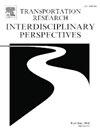Methodology for evaluating sidewalk based on continuous pedestrian movement on the sidewalk segment − A case study of Kochi city
IF 3.8
Q2 TRANSPORTATION
Transportation Research Interdisciplinary Perspectives
Pub Date : 2025-03-28
DOI:10.1016/j.trip.2025.101393
引用次数: 0
Abstract
A supportive environment can be achieved at the urban or community level when pedestrians navigate their surroundings easily. Every journey begins and concludes with walking; it is crucial to prioritise the infrastructure that enables smooth pedestrian movement. t is necessary to assess current pedestrian facilities and implement enhancements based on uninterrupted pedestrian flow to ensure adequate infrastructure. The methodologies outlined in the Highway Capacity Manual (HCM) and the Indian Road Congress (IRC) serve as guidelines for sidewalk assessment. This paper evaluates the relevance of evaluating the sidewalks based on continuous pedestrian movement (CpM) through a live case study in the urban setting of Ernakulam, Kerala, India and undertaking a thorough analysis to identify the drawbacks/shortcomings of the existing methodology in assessing the pedestrian level of service (PLOS) and quality of service (QoS). Our objective is to improve the current evaluation methodology by developing a new approach that addresses the various factors contributing to delays in pedestrian movement, which lead to conflicts on the sidewalk, based on Continuous Pedestrian Movement (CpM). This research highlights the inadequacies of the existing evaluation methodology but also proposes new assessment techniques adapted for any context with all types of delay except for snowfall areas. The study also evaluates the selected streets for the new methodology in understanding pedestrian sidewalks. Experts validated the proposed study methodology. Help the developers and planners efficiently and effectively determine the condition of existing sidewalk facilities to help them improve them if needed for all pedestrian users, especially vulnerable pedestrians.
基于行人连续运动的人行道评价方法——以高知市为例
在城市或社区层面,当行人在周围环境中轻松导航时,可以实现支持性环境。每段旅程都以步行开始,以步行结束;重要的是要优先考虑能够使行人顺畅移动的基础设施。有必要评估现有的行人设施,并根据不间断的行人流量实施改进措施,以确保足够的基础设施。公路容量手册(HCM)和印度道路大会(IRC)中概述的方法可作为人行道评估的指导方针。本文通过对印度喀拉拉邦埃尔纳库拉姆城市环境的实际案例研究,评估了基于连续行人运动(CpM)评估人行道的相关性,并进行了彻底的分析,以确定现有方法在评估行人服务水平(PLOS)和服务质量(QoS)方面的缺陷/缺点。我们的目标是通过开发一种基于连续行人运动(CpM)的新方法来改进当前的评估方法,该方法可以解决导致行人运动延迟的各种因素,从而导致人行道上的冲突。这项研究强调了现有评估方法的不足之处,但也提出了新的评估技术,适用于除降雪地区以外的所有类型延迟的任何情况。该研究还评估了所选街道的新方法来理解人行道。专家们验证了提议的研究方法。帮助开发商和规划者有效地确定现有人行道设施的状况,并在需要时帮助他们改善这些设施,以满足所有行人,特别是弱势行人的需求。
本文章由计算机程序翻译,如有差异,请以英文原文为准。
求助全文
约1分钟内获得全文
求助全文
来源期刊

Transportation Research Interdisciplinary Perspectives
Engineering-Automotive Engineering
CiteScore
12.90
自引率
0.00%
发文量
185
审稿时长
22 weeks
 求助内容:
求助内容: 应助结果提醒方式:
应助结果提醒方式:


